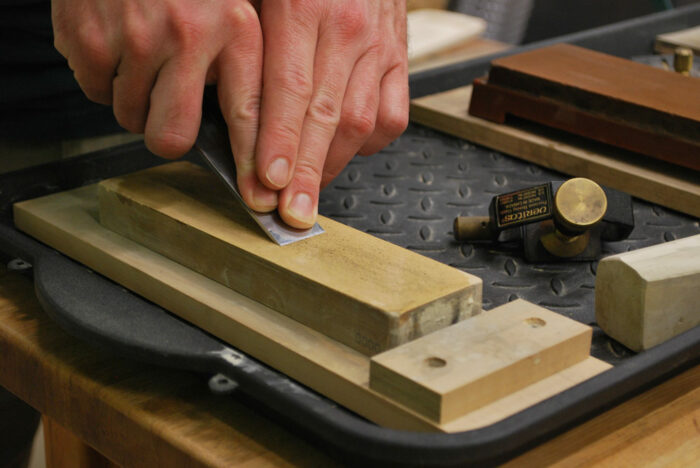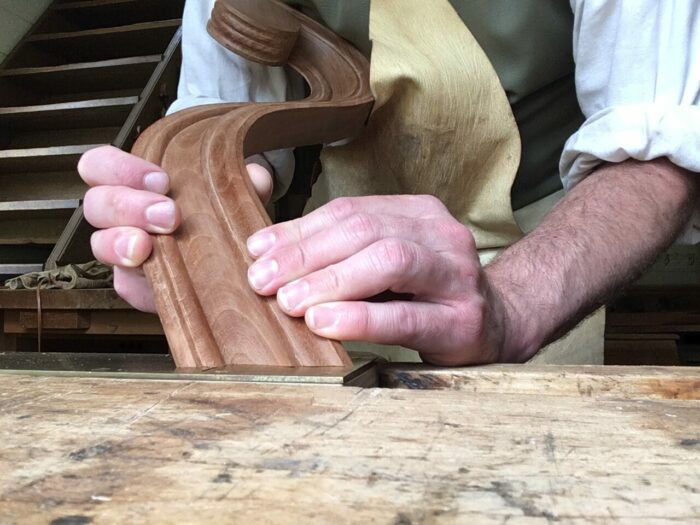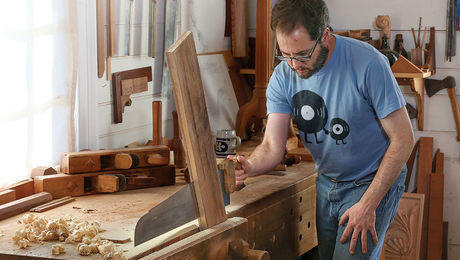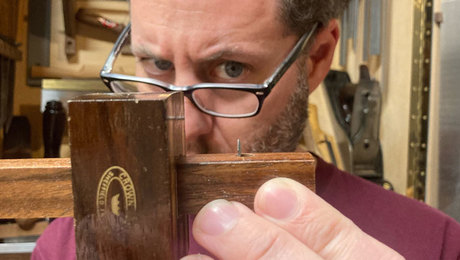Test yourself
Your honing guides and other hand-tool helpers aren't 'crutches'—in fact, they may be training you to do more accurate work.

“It’s a crutch.” “It’s training wheels.” Those are the two cliches of woodworking machismo that annoy me most. You know how it goes. Perhaps you just shared a picture on Instagram of your perfectly sharpened chisel with your new honing guide in the background. It’s likely that one of those phrases will rain on the parade of likes and celebratory emojis marching onto your feed. Perhaps you have just begun learning the craft (do these woodworkers also taunt children with actual training wheels?) or maybe you’ve developed an approach that works well for you. Either way, the comments are not helpful. Ultimately, we all have methods that work for us, so why demean others for following a different path? The hard way, it must be remembered, is not necessarily the best way.
But there is value in setting jigs and fixtures aside from time to time. There will always be a situation that requires a freehand approach. How do you know you’ll be prepared for it? Easy, you’ve got to test yourself. This is especially true when you are self-taught. Without the feedback of a teacher, you need to step back periodically, see what you’ve learned, and get a sense of what needs improvement. You may be better than you think.
Sharpening
Do you use a honing guide? I started out with one, but set it aside when I started working in the Hay Shop’s recreated 18th century environment because the use of guides is not historically accurate. Twenty years ago, guides were almost universally dismissed in woodworking literature (tool catalogs excepted). Fortunately, attitudes have changed, and many prominent woodworkers use and recommend honing guides. The guides also keep getting better. Despite all of that and my desire to not echo the bullies, the V-tool is coming. So too are the strange molding plane blades and all the other oddly shaped tools in your chest. Can you sharpen those with your guide? Well, before those tools get dull, test yourself with something easier. Here’s the thing about the “training wheels” insult: it’s true (in a non-insulting way). If you’ve only ever sharpened with a jig, odds are it has conditioned your body to move the tool consistently with wrists locked at the proper angle. It has helped train you.

To test yourself, grab a chisel or plane blade that has either a consistent, perfectly flat bevel or one that has been freshly hollow-ground. These will register nicely on the stone and provide better feedback. Rock the tool’s bevel on the stone until it displaces a little of the oil or water you’re using as a lubricant – that little bead of liquid lets you know that your bevel is fully in contact with the stone. Now, do your thing for a few strokes. How does it look? If things are uneven, troubleshoot. Is there a wobble on your forward or back stroke? How’s your posture? Would it help to lock your elbows and move with your hips? Keep checking and making adjustments every 10 passes or so. If you can get the job done, great. If not, try again next week. In the meantime, work on your technique while using your guide. None of this is to suggest you should ditch the honing guide. Instead, it’s a little self-check and a reminder not to fear sharpening the tools the guide can’t hold.
Sawing
Dovetail guides, miter boxes, and anything that keeps your saw cutting accurately can be nice tools. Use them, but once again, prepare yourself for the times when they won’t be able to help. I started woodworking with a magnetic sawing guide for dovetails and I used that thing until I broke the saw that was designed to work with it. Before I got around to replacing that saw, I tried some dovetails freehand with the nice traditional dovetail saw I had gotten for Christmas. This was 19 years and countless dovetails ago, but I vividly recall those first cuts: they came out perfect. Success didn’t spring from beginner’s luck or some special innate ability (I had neither). Instead, it came from all the pins and tails that the magnetic guide trained my muscles to cut. You don’t need to cut a whole set of dovetails to test yourself. Next time you’re dovetailing, simply lay out a line or two in the waste of the joint you’re about to saw. Cut that freehand and see how you did. Once again, troubleshoot any problems and come back to it later. This costs nothing in materials and very little in time, so just take your dovetailing temperature every now and then with this simple self-test.

Perhaps you’re one of those dovetail sawyers who eschews jigs, but saws well to the waste side of your line. You may have felt the need for that when you first started, but do you still need to? Test yourself with the same method as above. If you find that you can cut to your line successfully, then it’s time to saw with more confidence. Unlike jigs, which can improve accuracy and efficiency for some people, sawing far away from your line just wastes time later and is typically a less accurate approach in the end. Allowing a jig to guide your tool is sound practice, allowing fear to do the same is worth overcoming.
This same approach also works well for crosscutting and mitering. If there is enough wood on the waste side of your cut, try a freehand practice cut sometimes. Knowing you can saw well without a guide or miter box will give you the confidence to take on that strange angle or shape that won’t fit into your miter box or whatever fixture you’re used to using. I really wanted to cut the miters on this curved molding in my miter box, but there was no way to make it fit. Making a new fixture for only two cuts seemed like a waste of time, so I scribed my line and went for it. Certainly, years of practice helped, but so did that little test cut I made right before the real one. In the end, I only needed a few swipes over a plane to get the sawn miter adjusted to perfection (as pictured). You never outgrow the need to test yourself from time to time.

Testing yourself may seem like a small matter, but it can pay big dividends in the shop by improving your confidence to push your craft further. Most hand tools are “self-jigging” in some capacity. Just as a honing guide keeps your chisel at the proper angle, a wide saw plate is designed to keep the saw’s teeth on a straight path. The flat back of a chisel provides a reference to guide the tool, and so on. Learning to trust yourself to use a tool’s subtle built-in guide system is a crucial step in developing hand skills. An occasional self-test is a great way to measure your progress and boost your confidence. Stick with your jigs and fixtures if they work well for you, but get yourself to a point where you don’t fear sharpening the V-tool or doing whatever unusual task that comes your way. Then, the next time that grouchy master woodworker drops a “training wheels” comment, you won’t have to question your worth – just roll your eyes and keep scrolling.
 |
Handwork: Resawing by Hand |
 |
Trust your eye |
 |
A very good cabinetmaker |




























Comments
I put off carving for many years, in large part because of the sharpening hurdle. I could hone plane blades and chisels perfectly, but carving tools were daunting.
I took a class with Phil Lowe, and could sharpen just fine after one evening. It took a little longer to get really good, but getting that first obstacle out of the way is crucial.
GREAT, encouraging article. Thank you.
Every musician knows that if you "Want to get to Carnegie Hall? [you have to] "Practice".
I somewhat disagree.
Why miter boxes are conflated together with the dovetail guides? They're totally in different classes.
Free hand sharpening in general uses different strokes than the jig. A jig encourages full length reciprocal strokes with an edge set perpendicular to the direction, free hand sharpening gives better results with short circular strokes and an edge angled relative of the stroke direction. These are two different sets of motions and obviously free handing will always give inferior results when "jig technique" is employed.
Splitting a line with a saw takes maybe a few weeks of 20 mins practice sessions. How long does it take to learn it with a dovetail guide? Would it also train you to cut tenons? What about pieces too big or too small for a guide? What about half blind dovetail pins?
I get that some people want to use a guide. Nothing wrong with using a guide, let's just not make excuses like it's a valid learning technique. Because if it would be - we would see it employed schools or during apprenticing, mentioned in textbooks, etc.
A guide removes most of the risks and almost 100% ensures a desired result. If that's what a user is looking for - it's absolutely fine and acceptable. But in my opinion a jig teaches you a technique at about the same rate a ruler teaches you drawing straight lines or dividers teach doing a perfect circle.
Log in or create an account to post a comment.
Sign up Log in